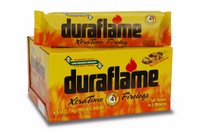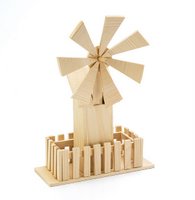 A recent comment on my earlier post "Wood Cased vs. Mechanical" questioned the relative environmental impacts of manufacturing these two types of pencils. I responded with a brief comment referring to a previous study commissioned by the Incense Cedar Institute a number of years back that reviewed the "cradle to grave" lifecycle impacts of Incense-cedar pencils to extruded plastic pencils and I believe also pencils which used composite slats produced from "recycled" paper. We're currently working to dig that old study up since the material would likely make for an interesting Timberlines post. However, it turns out the timing happens to be appropriate now to discuss one important aspect of the this life cycle given the introduction of our new Palomino Wood Crafter Hobby Kit. This aspect is the importance of developing markets for By-products in not just wood products manufacturing but any other industry for that matter.
A recent comment on my earlier post "Wood Cased vs. Mechanical" questioned the relative environmental impacts of manufacturing these two types of pencils. I responded with a brief comment referring to a previous study commissioned by the Incense Cedar Institute a number of years back that reviewed the "cradle to grave" lifecycle impacts of Incense-cedar pencils to extruded plastic pencils and I believe also pencils which used composite slats produced from "recycled" paper. We're currently working to dig that old study up since the material would likely make for an interesting Timberlines post. However, it turns out the timing happens to be appropriate now to discuss one important aspect of the this life cycle given the introduction of our new Palomino Wood Crafter Hobby Kit. This aspect is the importance of developing markets for By-products in not just wood products manufacturing but any other industry for that matter.Certainly with the increasing costs of raw material inputs over time there are both important financial and environmental benefits to developing by-product markets. There is a long tradition in the forest products industry of developing by-product markets for what originally was considered waste wood developed as a result of the primary lumber of finished wood products being manufactured. Typical wood by-products from sawmilling and remanufacturing facilities include: low/off grade lumber, bark, wood blocks, chipper stock and wood chips as well as shavings and sawdust. Some of these have long been used in other products such as generating pulp to make paper or cardboard products. However, in many cases even as recently as forty years ago many such by-products in the US forest products industry we're simply "hogged" up and burned off at the manufacturing site to prevent their accumulation. The old "teepee" shaped burner was a common sight adjacent to most sawmills. Fortunately, a combination of new clean air regulations and the improved overall efficiency and economic benefit of finding higher value markets has prevailed for a net reduction as well as the maintenance of lower total cost of manufactured wood products to consumers.
Today a whole host of by-product markets have been developed to make use of such materials. Examples include landscape bark, pet bedding, hog fuel for co-generation of electricity, Oriented Strand Board, Flake board and more. Eastern Red Cedar, a formerly important pencil wood species, is today used for production of closet linings and specialty wood items. Given this specied aromatic qualities, the waste sawdust is often distilled to extract cedar oil which is used as an essential oil base in many perfumes and household products.
Our own company has a strong history of being a leader in the area of by-products market
 development to utilize materials from our cedar slat operations. In 1969 we developed the first wood-wax manufactured firelog from our Incense-cedar sawdust by combining this with microcrystalene waxes, a "bottom of the barrell" type by-product from the petroleum industry. This product eventually became our Duraflame firelog which burns cleaner with less emmissions than firewood. Today with our slat manufacturing relocted to China Duraflame continues to use some Incense-cedar fiber from other wood products operations in California, but increaingly have expanded by using other sawdust and waste wood frm other manufacturers as well as agricultural by-products and new natural wax substitutes.
development to utilize materials from our cedar slat operations. In 1969 we developed the first wood-wax manufactured firelog from our Incense-cedar sawdust by combining this with microcrystalene waxes, a "bottom of the barrell" type by-product from the petroleum industry. This product eventually became our Duraflame firelog which burns cleaner with less emmissions than firewood. Today with our slat manufacturing relocted to China Duraflame continues to use some Incense-cedar fiber from other wood products operations in California, but increaingly have expanded by using other sawdust and waste wood frm other manufacturers as well as agricultural by-products and new natural wax substitutes.With our Incense-cedar pencil slat production our "Primary" driver products are reffered to as "wide ply" Select quality slats. These typically yield 8 to 10 pencils wide per slat depending upon the diameter of the pencil being produced. Our production of smaller narrow ply and shorter memo slats as well as lower grade recovery slats in addition to the prefered Select wide ply slats assures higher total yields of slats and pencils from the inbound Pencil Stock lumber. Marketing of such slats requires working closely with our pencil manufacturing customers to help them achieve the benefits of lower wood costs that can be obtained since there are generally trade offs in terms of efficiency and throughput. Memo slats for example are now a leading raw material source to produce "shorter" Cosmetic pencils. Certain narrow ply slats are more favorable for carpenter pencil widths than standard wide ply, etc. Slats even shorter than memos or narrower than standard production slats are also fingerjointed or now even edge glued to produce the wider standard length slats preferred by our customers for maximum throughput efficiency. Also now in our Thailand pencil facility we simply produce pencils ourselves on an OEM basis from Low Grade Slats for our other customers who prefer to focus just on using our more efficient higher quality slats in their higher labor cost environments.
With relocation of our pencil slat operations to China we have faced new challenges to develop
 higher value by-product markets for that. The Chinese market demographics and consumption patterns do not match up well for investment in Duraflame firelog production and freight costs from China to US for this type of heavy product are prohibitive. Most of our waste product has been sold of as lower value chips or hog fuel. While our expanding fingerjoint and edge glue operations will help we still have components of our waste stream have natural defects that are not appropriately recoverable into either process. Formerly, some such product was sold as is for craft purposes. However, given the lower labor cost structure in China we are able to recover and further process this waste streams in ways not previously possible n the US. As such we have developed and are pleased to introduce our Palomino Wood Crafter Kit. The first product is now available on our new eBay Pencil World Creativity Store Craft Materials Page. (Note: We're just selling from a very limited sample shipment of the prototype packs and waiting for arrival of regular inventory stock so if we sell out keep checking back on the Craft Materials page)
higher value by-product markets for that. The Chinese market demographics and consumption patterns do not match up well for investment in Duraflame firelog production and freight costs from China to US for this type of heavy product are prohibitive. Most of our waste product has been sold of as lower value chips or hog fuel. While our expanding fingerjoint and edge glue operations will help we still have components of our waste stream have natural defects that are not appropriately recoverable into either process. Formerly, some such product was sold as is for craft purposes. However, given the lower labor cost structure in China we are able to recover and further process this waste streams in ways not previously possible n the US. As such we have developed and are pleased to introduce our Palomino Wood Crafter Kit. The first product is now available on our new eBay Pencil World Creativity Store Craft Materials Page. (Note: We're just selling from a very limited sample shipment of the prototype packs and waiting for arrival of regular inventory stock so if we sell out keep checking back on the Craft Materials page)



No comments:
Post a Comment